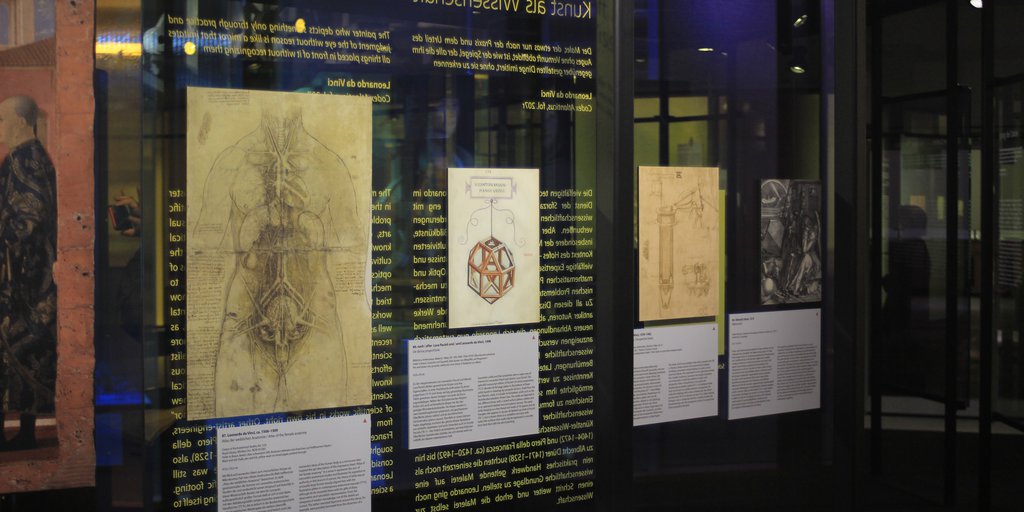
Science as Art, Art as Science <
The painter who depicts something only through practice and judgment of the eye without reason is like a mirror that imitates all things
placed in front of it without recognizing them
Leonardo da Vinci
Codex Atlanticus, fol. 207r. Translation: Elizabeth Hughes
The many and varied technical tasks Leonardo had to master in the service of the Sforzas were closely linked to scientific problems and challenges. But also the practice of the visual arts, especially painting, increasingly required theoretical knowledge and diverse expertise, particularly in the cultivated context of the court. This ranged from questions of optics and mathematical perspective construction to mechanical problems and medical knowledge. Leonardo now tried to learn systematically from the existing fundamental works by ancient authors related to all these disciplines, as well as from medieval sources and a growing number of more recent treatises. He expanded his library with specialist scientific literature and made concentrated and ambitious efforts to learn Latin and deepen his mathematical knowledge. This eventually enabled him to formulate new scientific insights of his own. He had now become an “author” of scientific works in his own right. Other artist-engineers, from Leon Battista Alberti (1404–1472) and Piero della Francesca (ca. 1420–1492) to Albrecht Dürer (1471–1528), also sought to place painting, which at the time was still considered a purely practical craft, on a scientific footing. Leonardo went one step further and elevated painting itself to a science.
Leonardo's Berlin Library: Section 8 <
- 70.
Tetragonismus
Edited by Luca Gaurico. Venice: Giovanni Battista Sessa, 1503
- 71.
Miscellanea
13th c.
- 72.
Prospectiva communis
Edited by Facius Cardanus. Milan: Petrus de Corneno, 1482
- 73.
Opere
1468–1492
- 74.
Summa de arithmetica, geometria, proportioni et proportionalita
Venice: Paganinus de Paganinis, 1494
- 75.
Divina proportione: Opera a tutti glingegni perspicaci e curiosi necessaria
Venice: Paganini de Paganinis, 1509
- 76.
Underweysung der Messung, mit dem Zirckel und Richtscheyt, in Linien, Ebenen unnd gantzen corporen
Nuremberg: Hieronymus Andreae, 1525
- 77.
Fasciculus medicinae. Similitudo complexionum & elementorum
Venice: Johannes and Gregorius de Gregoriis, 1500
 | 75.
Divina proportione: Opera a tutti glingegni perspicaci e curiosi necessaria Venice: Paganini de Paganinis, 1509 |

In 1498 Pacioli wrote a major work titled Divina proportione (On the divine proportion). Two magnificent manuscripts of this work exist with dedications to important personages. The treatise was printed in Venice in 1509 in an expanded form with two new sections, on architecture and regular polyhedra. In the manuscripts (86 ▲) and the printed edition, the splendid plates with illustrations of polyhedra were based on drawings by Leonardo. They are the only works of his that were printed in his lifetime. In the foreword, Pacioli explicitly paid tribute to his friend Leonardo, the artist-engineer.
References
Bambach, Carmen C. 2019a. Leonardo da Vinci Rediscovered. Vol. 1: The Making of an Artist 1452–1500. 4 vols. New Haven / London: Yale University Press, 41–44, 52.
Idem. 2019b. Leonardo da Vinci Rediscovered. Vol. 2: The Maturing of a Genius 1485–1506. 4 vols. New Haven / London: Yale University Press, 247, 461.
Contin, Duilio, Piergiorgio Odifreddi, and Antonio Pieretti, eds. 2010. Antologia della divina proporzione di Luca Pacioli, Piero della Francesca e Leonardo da Vinci. Sansepolcro, Arezzo: Aboca Museum Ed.
Giusti, Enrico, and Carlo Maccagni, eds. 1994. Luca Pacioli e la matematica del Rinascimento. Exhibition catalogue Fondazione Piero della Francesca, San Sepolcro, 13.4.–27.6.1994. Florence: Giunti.
Vecce, Carlo, ed. 2019. Leonardo and His Books. The Library of the Universal Genius. Exhibition catalogue Museo Galileo, Florence, 6.6.–22.9.2019. Florence: Giunti, 124, no. 12.4.









